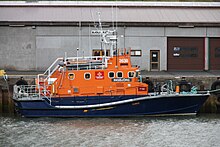ICE-SAR

The Icelandic Search And Rescue Association ( ICE-SAR , Slysavarnafélagið Landsbjörg ) is the Icelandic rescue organization for air, land and water rescue.
initial situation
The island of Iceland has an area of 103,000 km² and is surrounded by the North Atlantic at 77 ° latitude. Settlement of the island is concentrated in the coastal regions, but the population density there too is relatively low with a total of only 300,000 Icelanders. Large areas are still free of human influence and the central highlands are virtually unpopulated. The island has several large areas of glaciers, volcanoes, scree deserts and enormous relief energy . Every year there are unpredictable activities happening everywhere due to the abundance of geothermal activity. Volcanic eruptions, earthquakes, extreme weather conditions and heavy snowfall are natural phenomena that the people of Iceland have to deal with on a regular basis. The small state of Iceland has no army and only a small coast guard with a few ships and aircraft.
history
NGOs have always played an important role in aid operations in Iceland. ICE-SAR goes back to a first Westman Island Rescue Team (Björgunarfélag Vestmannaeyja) from 1918. SAR work in Iceland also has a long tradition in sea rescue. A number of serious accidents occurred in the 1920s. The voluntary SAR rescue teams along the coast rescued hundreds of people in distress over the years at the risk of their lives.
ICE-SAR is proud of the introduction of many modern rescue equipment on the island: the first rescue cruiser and the first rescue helicopter were introduced by ICE-SAR, as well as measures for traffic safety and an automatic ship positioning system. A survival training center was also initiated by the organization. In 1999 the various rescue units merged to form ICE-SAR.
organization
ICE-SAR combines all common rescue units in one organization: mountain rescue , disaster control , water rescue , sea rescue and air rescue . ICE-SAR is recruited from thousands of volunteers who work in the organization's rescue teams. In addition to the rescue teams, there is an accident prevention department and a youth department. The organization's president is Smári Sigurðsson.
In Hellissandur in the south-west of Iceland, the organization operates a small training center. It uses the former US military facility around the Gufuskálar u. a. for earthquake exercises for their detection dog teams.
Search and Rescue Teams
Around 100 rescue teams form the core of ICE-SAR work. They are spread all over Iceland and have a total of 3000 volunteers who are always ready for action. The teams are trained for SAR operations on land, mostly in high alpine terrain and on the sometimes very stormy seas around Iceland. The teams receive regular training in their specialist areas. All-terrain vehicles, snowmobiles and lifeboats are at your disposal.
In recent years, the specialization has been expanded so that the following teams are now available: land teams, sea teams, diving groups (rescue divers) , mountain rescue teams, rescue dog groups, etc.
Maritime Safety Section and Sea Rescue
ICE-SAR has 14 lifeboats stationed around Iceland. In 1987 a permanently manned MRCC was set up by the Icelandic Coast Guard ICG, which also coordinates the sea rescue operations of ICE-SAR ships. The Coast Guard has also had airplanes since 1955 and helicopters since the 1960s. These helicopters support ICE-SAR's operations at sea, but also on land.
ICE-SAR's Maritime Safety and Survival Training Center (MSSTC) has been conducting safety training courses since 1985. The training sessions are mostly carried out by the crews of the fishing boats. An Icelandic law specifies safety training for new fishermen.
Travelers reporting service
ICE-SAR operates a so-called Travelers Reporting Service. Hikers can contact ICE-SAR and leave information about their planned hikes. If they do not report back, ICE-SAR begins to investigate and, if necessary, to initiate relief measures. Hikers can report directly to the ICE-SAR-HQ in Reykjavík and receive advice there about possible dangers of their project.
PLB
Personal Location Beacons are personal beacons with which a personalized emergency call can be made on the frequency 406 MHz. They are part of the Cospas-Sarsat system. The devices can be rented from ICE-SAR.
Emergency shelters
ICE-SAR is also responsible for a traditional Icelandic facility: the nationwide emergency shelters in remote coastal regions and in the mountains. The huts are equipped with a radio and serve as a starting point for people in need. Usually they are painted orange-red. In recent years, vandalism has also become a bigger problem in Iceland: tourists misappropriated the huts and thus caused the annoyance of many volunteer Icelandic helpers who take care of the huts on a voluntary basis.
Alerting
ICE-SAR can be alerted via the Icelandic emergency telephone number, marine radio and 2 m amateur radio channels.
- European emergency number (including mobile phone): 112
- Message service from ICE-SAR on the danger and weather situation in the mountains: +354 570-5900
- by phone from See (Coast Guard): +354 511 3333
International assignments
ICE-SAR teams were one of the few teams in the world to receive the IEC Classification from INSARAG (International Search and Rescue Advisory Group), which works under the umbrella of the United Nations . ICE-SAR teams are among the first response teams for major international incidents.



